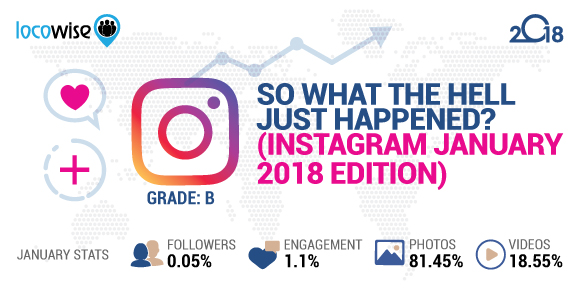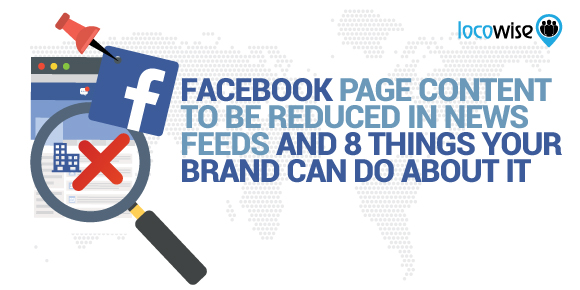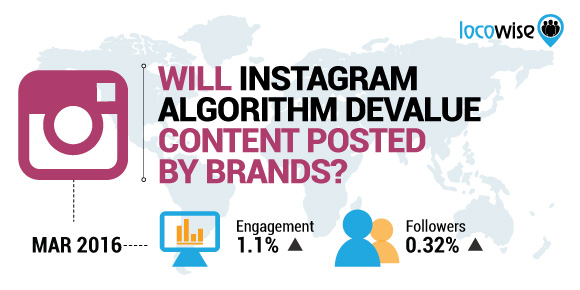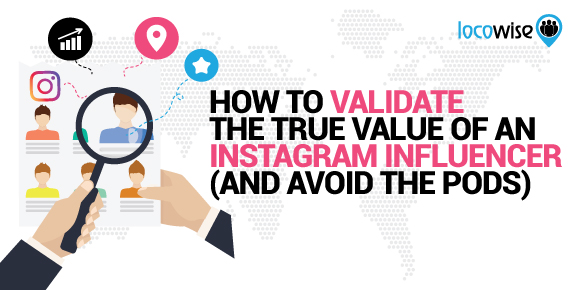So What The Hell Just Happened? (Instagram January 2018 Edition)
Sahail Ashraf posted on 19 February 2018
Before we jump into Instagram and what happened to it in January, we thought we’d do the usual and go through our stats and figures on the platform.
We’ve also introduced a new grade card approach, which should help you and your clients see how it’s improving (or not) as a platform.
Let’s get started with our Instagram monthly growth and engagement study for the month of January 2018.

Post type breakdown
A huge 81.45% of the posts on Instagram in January were image posts. This stacks up well against December 2017’s 80.52%.
With regards to video posts, they got the remainder of the share, at 18.55%.
Growth and usage
The number of followers across the platform grew by 0.05%, compared to the 0.06% in December.
Brands posted on Instagram 3.27 times per day in January, compared to the 3.32 times in December 2017.
Engagement
Videos on the platform engaged 0.8%, no change from December.
When it comes to photo engagement, it was at 1.1% in January 2018, against the 1.2% in December 2017.
Grade: A
Grade: B
Grade: B-
Overall grade: B
Meanwhile, #backlash
Instagram didn’t have an amazing January. Most of the Internet didn’t have a great January anyway, but a couple of things seemed to annoy everyone who uses Instagram even just every now and then.
Maybe it’s a backlash.
It probably isn’t, but the darling platform of 2017 is showing, here and there, a bit of weakness.
For example…
It pulled out a new feature that looked kind of old
Instagram unveiled a new feature in January. It allows users to know when another user is active on the platform, or was active and when.
We know, practically every single communication app does this (Skype even does this), but Instagram saw it as a feature and made a big thing of it in January.
The response? Well, no one’s been out burning Instagram flags yet, but at the same time, no one really, really wanted the feature in the first place. It’s useful if you are in the midst of an important conversation or photo party, but not much else.
And they’re showing you stuff you don’t want to see
That’s right, in a move that’s largely been seen as a way of boosting advertising revenue, Instagram has decided to show users posts they ‘might like’.
This has not gone down well. Some users have simply responded with (frankly) very angry voices, while others have just bemoaned the way Instagram is becoming a money-grabbing ad machine.
If a user sees all the posts from people they follow, some more posts will come up that are curated by the platform. These are from people and accounts the user doesn’t follow. The problem is that people like Instagram because it feels very personal. Once you have your friends on there and you are seeing regular posts from them, it feels even more insular and welcoming. Instagram has now thrown what will eventually become an ad engine into the mix.
To be fair, the company is doing it for what seems like legitimate reasons:
“After you’ve viewed all new posts in your feed, we will suggest some additional posts you might like…” Gabe Madway, Instagram
However, while it makes sense to show you stuff you might like, we reckon people use Instagram because it used to not have that feature.
But at the same time, Instagram made it easier for brands to distribute organic content
Instagram really wants brands to enjoy being on the platform. This is because it knows that this will prove to be the big thing in the future.
It’s time we all pondered, for the moment, what has happened over at Facebook. That platform has lost users and the trust of some people due to its previous inability to stop fake news and nasty content from being uploaded to Facebook. Now it is taking the emphasis away from brands and placing it firmly on a user’s real social life. Brands will have to accept the necessity of paid advertising if they want to continue to make gains on Facebook.
But Instagram is now allowing organic posting from brands to be even easier, rather than more difficult. In January it announced a new feature, which allows brands to schedule organic posts.

In essence then, Instagram is becoming what Facebook used to be and Facebook is becoming more like what Instagram used to be. Yes, we’re confused too. But in a nutshell, Instagram is becoming more commercial, and Facebook is becoming more social.
And the rumour mill went into overdrive
The biggest problem with Instagram for many brands and perhaps even individual private users has been the algorithm. While no one really expected the Instagram algorithm to be easy to understand, the sheer genius of it is the fact it is unfathomable. No one knows what is going on with the Instagram algorithm. So this creates rumours.
The biggest rumours in January 2018 focused on hashtags. It’s apparently ‘almost true’ that Instagram is aiming to categorise posts with a large number of hashtags as spam. This has not been officially announced by Instagram, but people think it’s a fair piece of speculation.
Instagram officially allows up to 30 hashtags in a single post. While you don’t see that many posts hitting that limit, it’s there. Rumours are now circulating that suggests Instagram is going to start seeing excessive hashtag use as spamming.

Also, if you’re in a situation where you get into a routine and use the same hashtags again and again in your posts, then this may need a review. It’s rumoured that Instagram bots will see the same tags being used again and again as being spammy too.
Comment pods could be in trouble
A new thing from last year was the arrival of the comment pod. In each pod, groups of bloggers and some influencers would band together, and ensure that they would comment and like other posts within that group. Sometimes, they commented too. The comments were often as comments should be: detailed, informative and relevant. But some weren’t.
Many of the rumours that surfaced in January 2018 centered around these comment pods. People genuinely expect them to be reduced in number because Instagram wants to get rid of them. It’s all to bring a little more integrity to engagement and the impact brands, for example, have on the platform.
And when we say ‘reduced in number’, we mean banned.

Hashtags aren’t all bad
Users can now follow hashtags. This is a better and more exciting development than you probably think it is. It allows your client’s brand to build more engagement. Instagram will be legitimately seeing following hashtags as engagement. In other words, it’s now an extra way to show value to clients.
We love using our metrics to make the world a better place. Data means progress (and happy clients). Want this? Sign up for a free seven-day trial.


